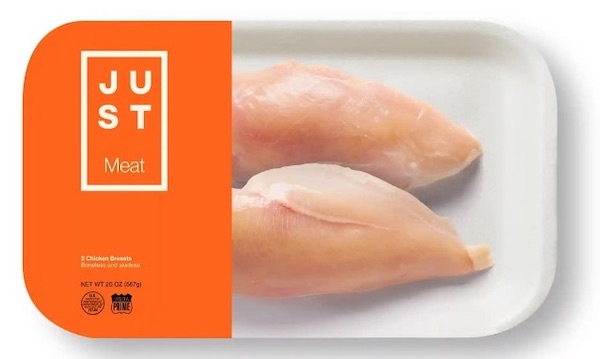
Lab to Bun? Could this be the Future for Meat?
A Meat and Dairy Industries Article from All-Creatures.org
FROM Ruth
Toporoff, Animal Blawg
March 2021
Cell-based meats is not without its challenges. Without more independent reviews of the scientific data it is hard to establish necessary regulatory framework. While the USDA and FDA reached agreement on over-seeing responsibilities of the packaging, there has been no agreement on how the cell-based products will be labeled. This is a huge issue, as perception by the public is critical.

Imagine eating as much meat as you like, without hurting an animal or damaging the environment? Without killing a single animal – you can barbecue a burger that has all the taste and texture you remember from the taste of meat?
Solutions are needed to supply the massive demand for protein. Solutions
that do not contribute to animal welfare, that aid in food safety, and
diminish the damage to the environment that is done by organizations such as
CAFO (Concentrated Animal Feeding Operations). CAFO’s operate under
stressful and crowded conditions leading to the spread of disease and food
safety risks. Resolutions are needed to put an end to the horrors of factory
farming. Acceptable substitute products are required. What if that solution
was not a substitute but in fact was actual meat? Meat that would surpass
acceptable and be exceptional, all while not harming animals, circumventing
contagious diseases, and not damaging the environment.
Unlike plant-based meats, cultured meat is a lab-grown meat alternative
produced from animal cells. Cell based meat products are cell-for-cell
identical to the meat from animals but factory-produced from stem cells
rather than from live animals. On August 5th in 2013, Dutch scientist Mark
Post, founder of Mosa Meats, presented the first cell-cultured hamburger to
the world. It was produced from bovine muscle cells grown in the lab and
cost €250,000 ($295,000) to make. They now project a “beef” patty to cost
around €9 ($10.62). While it was not perfect, it was an anti-biotic-free,
slaughter-free start to a solution to the many problems of CAFO’s abuses.

Mosa Meat’s cell-based hamburger, image supplied by the company
The Singapore Food Agency approved the world’s first cultivated meat product
for sale in December 2020. Shortly thereafter, “Restaurant 1880” in
Singapore marked the first commercial sale of approved cultivated chicken
bite by California-based Eats Just.
Why Change is Needed
The billions of animals “living” in cramped, filthy, overcrowded spaces with
almost no room to move their antibiotic-fueled bodies create a perfect storm
for the next zoonotic disease to emerge and spread. The Pandemic made it
clear how animal transmission of disease thru food consumption can bring
death to humans and bring down an entire world economy. It has shown how
contagious disease can spread from animals to humans with the potential to
harm by way of the food system.
Legislation has been ineffective to help protect the animals or enforce
proper supervision thereby allowing food processing plants to perform at
dangerously low standards that increase the probability of transmission of
contagious viruses. The threat of disease is not new as infectious diseases
such as salmonella and E. coli exist. Recent pandemic virus threats from
swine flu and bird flu almost certainly evolved on chicken and pig factory
farms.
Environmental Protection Agency has failed to regulate the environmental
impacts. CAFO’s produce more than 1 million tons of manure daily. This waste
is stored in large open lagoons which spill over into other water bodies,
contaminating and killing fish populations. Consequentially, running off
into our major waterways like the Great Lakes and Gulf of Mexico which
impact drinking water supplies, aquatic ecosystems, etc. CAFO’s emit
pollutants that contribute to respiratory illnesses and are one of the
largest emitters of methane gas emissions in the country. CAFO’s unregulated
operations diminish the quality of life in neighboring communities, and
often it is those of lower socioeconomic that pay the price. Complicating
efforts are the corporations that have a vested interest in keeping the food
system profitable above all, and are powerful enough to influence policies,
so that their profits come ahead of people’s and animal’s interests.
But a quiet revolution is taking place in labs, where scientists are working
to cultivate meat and seafood grown from cells, with the potential to reduce
demand for industrial animal agriculture even further.
How the change happens
Stem cells are taken from the muscle of an animal, usually with a small
biopsy under anesthesia, then they are put with nutrients, salts, pH
buffers, and growth factor. Next, they are left to multiply. Finessing the
technology and getting the cost to an affordable level initially happening
at a slower pace, but quicker with the awareness to animal transmitted
disease of the Pandemic. With increased investment, products will be ready
for market sooner than was ever expected.
Memphis Meats, a Berkeley startup, was founded by cardiologist Dr. Uma
Valeti and cell biologist Dr. Genovese in 2015. Memphis Meats uses
myosatellite cells to grow meat products, and has produced cultured chicken
nuggets and beef meatballs, as well as duck tissue. In January, they raised
$161 million by fundraising in the largest funding ever completed by a
cultured meat company. This attracted high-profile investors, including Bill
Gates and Richard Branson. It also counts meat industry giants Cargill and
Tyson Foods among its backers. Additionally, Artemys Foods, by biochemist
Jess Krieger, who has spent the past six years working in University growing
cell-based meat in a lab, Berkeley-based Mission Barns, focusing on creating
animal fat, which mixed with other ingredients to make duck sausages, and
BlueNalu, developing seafood from fish cells through a process called
“cellular aquaculture.”
Cell-based meats is not without its challenges. Without more independent
reviews of the scientific data it is hard to establish necessary regulatory
framework. While the USDA and FDA reached agreement on over-seeing
responsibilities of the packaging, there has been no agreement on how the
cell-based products will be labeled. This is a huge issue, as perception by
the public is critical. Missouri has already passed legislation banning
cell-cultured meat from being called “meat.” Labeling is important, because
at the DNA level, this is meat. Regulation is a bigger barrier to entering
the marketplace then the technology, which is ready.
One study found that cell-based beef is projected to use 95 % fewer global
greenhouse gas emissions, 98 % less land and half as much energy. And since
the animal cells are extracted humanely and grown in a facility rather than
within the animals themselves, cell-based meat has the potential to all but
eliminate animal suffering.
Return to The Meat and Dairy Industries
Read more at Clean Meat Hoax Articles
Animal Slaughter Kill Counter:
Number of animals killed in the world by the fishing, meat, dairy and egg industries, since you opened this webpage.
0 marine animals
0 chickens
0 ducks
0 pigs
0 rabbits
0 turkeys
0 geese
0 sheep
0 goats
0 cows / calves
0 rodents
0 pigeons/other birds
0 buffaloes
0 dogs
0 cats
0 horses
0 donkeys and mules
0 camels / camelids








